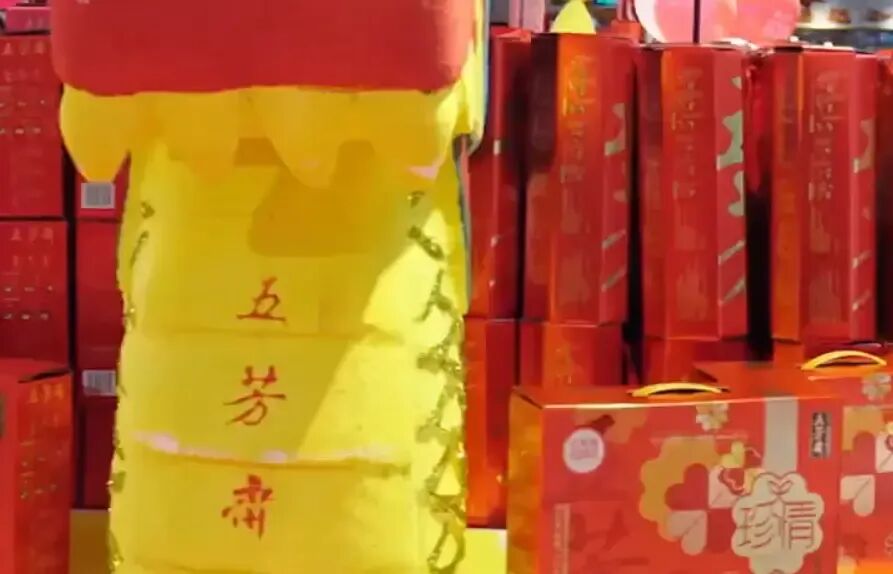
Positive Reviews: A Century of Heritage and Transformation Attempts, Time – honored Brands Still Hold Potential to Break Through
As a “Time – honored Chinese Brand” established in Jiaxing in 1921, the brand value and industry status of Wufangzhai cannot be underestimated. Its label of “National Zongzi” not only carries the taste memories of several generations but also, relying on its solid product strength and standardization ability, makes it the leading drafter of the International Standard for “Zongzi”. This brand moat, jointly constructed by historical precipitation, consumer trust, and industry discourse power, is Wufangzhai’s most core “trump card” in the competition. Even if it is currently in trouble, its brand recognition and market foundation still provide natural advantages for subsequent transformation. Consumers usually have a higher tolerance and expectation for time – honored brands than for emerging brands, which leaves room for Wufangzhai to repair trust and regain market recognition.
In addition, although Wufangzhai’s strategic exploration in recent years has not met expectations, its willingness to transform is worthy of affirmation. From proposing the “Glutinous +” strategy in 2019 to expand the glutinous rice food market, to laying out the overseas market starting in 2024, and then to initiating preparations for listing on the H – share market in 2025, these actions indicate that Wufangzhai has not been complacent in the comfort zone of “single – zongzi dependence” but is trying to break the growth bottleneck through category expansion, internationalization, and capital operation. This awareness of actively seeking change is a necessary attitude for traditional enterprises to cope with the changes of the times. Especially in the context of intensified competition in the food industry and diversified consumer demands, if a time – honored brand wants to “survive the next century”, it must break out of the mindset of “living on past achievements”. Although Wufangzhai’s attempts have flaws, the direction itself conforms to the industry trend.
What is even more noteworthy is that Wufangzhai’s status as an “industry benchmark” still has potential value. As an international standard setter, its experience in production technology, quality control, and other fields should have become its core competitiveness. If it can re – strengthen the foundation of quality control and transform the standard advantage into a “quality guarantee” that consumers can perceive, Wufangzhai is fully capable of重塑 its brand image of “safety and reliability” and then establish a differentiated barrier in the red – ocean competition.
Negative Reviews: Quality Failures and Strategic Imbalances, Time – honored Brands Plunge into a Double Crisis of Trust and Growth
For food enterprises, quality is the lifeline, and Wufangzhai’s frequent “failures” in recent years have seriously shaken this foundation. From the bugs in taro zongzi, the unknown foreign objects in red bean paste zongzi, to the suspected blood – stained band – aid in the OEM products, consumers’ complaints about Wufangzhai are mainly focused on “loopholes in production – process control”. As the setter of industry standards, Wufangzhai should have been the “benchmark” for quality control, but it can hardly meet the most basic requirement of “no foreign objects”. This contrast between being a “standard setter” and a “problem creator” is a fatal blow to brand trust. More importantly, in response to consumers’ doubts, Wufangzhai’s responses often stay on the surface of “establishing a special task force” and “conducting a comprehensive investigation”, lacking public explanations of the root causes of the problems and specific commitments to improvement measures. This attitude of “emphasizing crisis public relations and neglecting fundamental solutions” further consumes consumers’ patience. The establishment of trust requires long – term accumulation, but it may collapse in just one “perfunctory” response.
The single – mindedness of the business structure and the ineffectiveness of strategic implementation have trapped Wufangzhai in a “growth dilemma”. Although the “Glutinous +” strategy was proposed in 2019, the performance of non – zongzi businesses has always been weak. In 2024, the mooncake series only increased slightly by 3.46%, and other categories even declined. During the same period, the revenue of the zongzi business still accounted for more than 70%, and it was highly dependent on seasonal sales in the first half of the year. This “one – legged walking” model not only leads to drastic fluctuations in performance (the revenue growth rate was positive and negative from 2022 – 2024, and in the first half of 2025, it even faced a situation of “increasing revenue but not profit”), but also makes Wufangzhai more and more passive in the increasingly competitive zongzi market. Snack giants such as Liangpinpuzi and Three Squirrels are encroaching on the market, while bakery brands such as Yuanzu and Qianji are taking away the high – end market, and local time – honored brands are holding on to their regional markets. Wufangzhai’s “zongzi base” is being continuously eroded.
The “much – ado – about – nothing” overseas expansion has exposed Wufangzhai’s lack of strategic implementation ability. Although it established companies in Singapore, France, Japan and other places starting in 2024 and expanded into the South Korean and UAE markets in 2025, the proportion of overseas revenue has always been less than 1% (0.7% in 2024 and 0.4% in the first half of 2025), and the gross profit margin is far lower than the overall level (31.82% vs 40.74%). Even more ironically, in August 2025, the mung bean paste mooncakes exported to South Korea were returned due to excessive preservatives, directly reflecting Wufangzhai’s neglect of the compliance requirements of the overseas market. This strategy of “emphasizing layout and neglecting in – depth development” has made the overseas business not only fail to become the second growth curve but also become a drag. At this time, if Wufangzhai initiates preparations for listing on the H – share market without solving the core problems of quality and growth, the introduction of capital may intensify the vicious cycle of “performance pressure – blind expansion”.
Advice for Entrepreneurs: Key Propositions for the Transformation of Time – honored Brands from Wufangzhai’s Dilemma
Wufangzhai’s case provides multiple warnings and inspirations for entrepreneurs (especially those in time – honored brands or traditional industries). Based on its pain points, the following advice is worth considering:
Hold the Quality Line and Build a “Perceivable” Quality Control System: In the food industry, trust is built on “the safety of every bite”. Entrepreneurs need to upgrade quality control from “passively responding to complaints” to “actively transparent management”. For example, they can publicize the monitoring videos of key production processes, introduce third – party quality inspection agency certifications, and establish a “Quality Supervision Committee” involving consumers. Wufangzhai’s lesson shows that relying solely on the title of “industry standard setter” cannot win the trust of consumers. Trust must be rebuilt through specific and perceivable actions (such as publicizing the problem – tracing results and setting a schedule for improvement measures).
Beware of “Single Dependence” and Create a Business Structure of “Main Category + Ecosystem”: Wufangzhai’s “single – zongzi dependence” is essentially the risk of “over – concentration of the core category”. Entrepreneurs need to plan in advance a gradient layout of “main category – related category – innovative category” to avoid the collapse of overall performance due to market changes in a single category (such as intensified competition and seasonal fluctuations). For example, they can use the “main category to build the brand” (such as Wufangzhai’s zongzi), the “related category to expand the scale” (such as extended products like glutinous rice cakes and glutinous rice wine), and the “innovative category to drive growth” (such as low – sugar and low – fat glutinous rice snacks targeting the young group) to form the “anti – cycle ability” of the business.
Internationalization Should Be “Compliance – First and Then Expansion”, Avoiding “Going Global for the Sake of Going Global”: The setbacks in Wufangzhai’s overseas business are mainly due to insufficient preparation for the local needs and compliance requirements of the target market. If entrepreneurs plan to go international, they should first study the food safety standards (such as additive restrictions), consumption habits (such as taste preferences), and channel characteristics (such as Chinese – community stores vs local supermarkets) of the target country, and then verify the feasibility of the model through small – scale trial sales instead of “scattering the net widely”. For example, they can first focus on areas with a large Chinese population (such as Singapore and Chinatowns in the United States), strengthen the “cultural symbol” attribute through festival marketing, and then gradually penetrate into the local consumer market.
Capital Operation Should Be “Business – Oriented”, Avoiding “Raising Funds for the Sake of Raising Funds”: The original intention of Wufangzhai to initiate preparations for listing on the H – share market was to accelerate internationalization, but when its core problems (quality and growth) remain unsolved, the introduction of capital may magnify performance pressure. Entrepreneurs need to be clear that financing is a means, not an end, and the use of funds must focus on “solving the core business pain points” (such as upgrading production lines, researching and developing new categories, and optimizing the supply chain). Before introducing capital, they should first verify the sustainability of the business model to avoid resource misallocation caused by “expanding for the sake of listing”.
Attach Importance to Consumer Communication and Shift from “One – Way Output” to “Two – Way Interaction”: The reason why Wufangzhai’s responses to quality problems have been criticized is that its communication with consumers stays at the level of “official statements”, lacking emotional resonance and action commitments. Entrepreneurs need to establish a “consumer co – creation” mechanism. For example, they can collect product improvement suggestions through social media, invite users to visit the factory, and provide “one – on – one” solutions for complaining users and publicize the improvement results. This kind of interaction can not only repair trust but also transform consumers into “brand propagators”.
The transformation of a century – old time – honored brand is never about “subverting history” but “activating history”. Wufangzhai’s dilemma is essentially a disconnection between traditional advantages (brand, standards) and new – era demands (quality, diversification). For entrepreneurs, whether it is a time – honored brand or a new brand, the core logic remains the same: respond to consumers’ trust with solid product strength, cope with market changes with flexible strategies, and maintain the brand’s warmth with a sincere attitude. Only in this way can they “survive” and “thrive” in the wave of the times.




![Founder’s Q&A “[New Consumption Landscape] Pricing Power for the Youth: How to Sell “Self-inflicted Experiences” at a 300% Premium?”](https://aiwiselnk.com/wp-content/themes/dashscroll/img/thumb-medium.png)